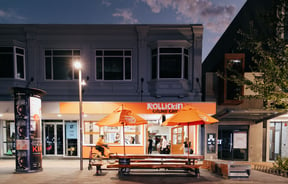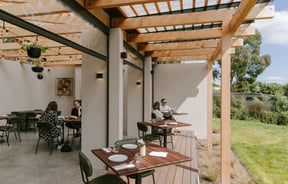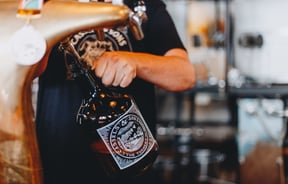New Brighton Good Life Guide: Pierside Developers Robbie & Chris Harris

Robbie and Chris Harris are the city's most under-the-radar developers. However, soon, there will be no hiding from the most exciting and ambitious development in New Brighton in decades: Pierside, the seaside suburb's new hospitality, market and entertainment hub. We chatted with Robbie about their backgrounds, New Brighton’s assets, commercial past and the vision.
Tell us a little about the journey that led you both here
I studied mechanical engineering at Canterbury University, then did an internship and some work for Enztec. Dad had City Firewood, and Mum (Liz) was a property investor. I worked at City Fire Wood before taking off overseas, but while away, I realised the potential in the business and was more hooked than I thought. I returned after six months and eventually brought the business off Dad. It started in 1982, so keeping it in the family was great.
Naturally, Chris and I wanted to follow Mum into property investment. We started with some small properties to dip our toes in. My role was to find opportunities and get the deal; Chris led the renovation and construction process. I saw the Pierside building was for sale and was interested instantly. Chris spent time working on the coast in Nice, France and could also see the potential. However, this project was beyond what Chris and I could do alone, so we showed Liz to see if she was interested in us all doing it together, and she was. Another developer was working on the other side of the mall, but that fell through, so we ended up purchasing that property and quickly found we were all in, and the vision expanded to what it is today: Pierside.
You're super passionate about the commercial history of New Brighton. Can you fill us in on that?
New Brighton has one of the most unique stories of any area in New Zealand. The key to understanding New Brighton is to look into the past. The first English settler’s home in the area was built in 1858, with more people moving in in the 1860s. The first hotel was built in 1872. In the 1880s, development began to accelerate, and around 1000 residents lived there by the turn of the century, quadrupling over the next twenty years. Early references to New Brighton give it the nickname Canterbury’s playground and a seaside and health resort. This is unsurprising, given that beaches are universally recognised as prime destinations for recreation and leisure.
As the population grows, beach towns often become centres for cultural and recreational activities to attract visitors. If you were to visit New Brighton in the 1920s, you would have been able to travel out from the city on the tram and spend the morning at the beach, walk the pier and take a swim. If the ocean was too cold, you could have visited the Hydro Hot Water Salt Baths, enjoyed an open-air concert at the Rotunda or caught a movie in the 350-person capacity picture theatre. If you were from out of town, you could stay at one of the numerous hotels or smaller boarding houses. This was the trajectory in New Brighton from its establishment in the mid-19th century, but a series of events would eventually set things off on a new path.
In the 1930s, the labour government fixed a 40-hour week as the standard for most workers in factories and workshops. Trade unions, however, wanted a 40-hour work week for all workers, thus limiting shop hours to a 40-hour work week. Consequently, from 1945 until 1980, shops across New Zealand were closed on Saturdays and Sundays. In the 1960’s, New Brighton became the exception to this rule and the only place in Christchurch for people who worked all week to shop. It was also the only place to go where things were happening. The result was an immense retail boom; every shop wanted to be in New Brighton. Over the next twenty years, the commercial growth in New Brighton was unprecedented. Entire neighbourhood blocks were bulldozed to make way for new buildings, arcades and blocks of shops. The small recreation-based town centre of 1960 was increased tenfold into Christchurch’s mega-mall by the 1980s. However, development and growth became stagnant in 1980 when the rest of New Zealand could open on a Saturday, marking the end of the boom and the beginning of the bust.
It is widely accepted that new indoor shopping malls outcompeted New Brighton, ultimately leading to its decline, but New Brighton should never have been a retail centre in the first place. As a retail centre, New Brighton was established on conditions that gave it a competitive advantage, but these had nothing to do with its location or other positive attributes. Any suburb in Christchurch could have reached the same heights as New Brighton if given the same exclusive rights to Saturday retail for 20 years. When Saturdays opened up, most people living in Christchurch or surrounding areas had somewhere closer to scratch that shopping itch. With a decrease in foot traffic, rents started to decline and desirability compounded.
Eventually, the earthquake happened, and was the straw that broke the camel's back after 30 years of slow decline. The rest of the city has emerged on a trajectory that, in time, will far surpass the path it was on before the earthquake, and New Brighton too has this same opportunity, to reconfigure and emerge better than it could have otherwise.
Establishing the He Puna Taimoana Hot Pools was a major turning point. This relatively small act has kickstarted the resurgence of New Brighton because it has provided a small stimulus and is so essential. Symbolically, the investment aligned with what worked in New Brighton before the 1960s. It demonstrates that investing in recreation/leisure in New Brighton is met with success, adding credence to the idea that creating a recreational destination is the key to a pathway forward.
How has that background contributed to Pierside's vision?
The background is the basis for the Pierside development, looking back to the time when New Brighton was thriving on its own merits. Weaving in what is missing for locals is important while also utilising the blank canvas created by the earthquake to rethink what the seaside experience could be in Christchurch.
Let's hear about Pierside
The old Mediterranean-looking building will become The Pavilion, with a gastropub and entertainment venue upstairs and a couple of restaurants with shared office spaces above. This hospitality venue creates a hub for locals to come for food and beverage. However it is still condensed with a variety of curated operators covering a wide range of different but complementary experiences.
Working with the Village Green Project, the green will be at the heart of Pierside. It will be a community gathering point and an event centre, like the modern-day equivalent of the band Rotunda. Markets, festivals, carnivals and concerts will further enhance the area and tap into the surrounding hospitality. Towards the back of the development, a focus on local services and health builds on the gaps.
The design we have chosen embraces the beach and creates a vibrant hub. With unique colouring, further enhanced by colourful nighttime lighting, the area will create a unique visual affair, making it a must-see destination for tourists and offering fantastic photo opportunities and an exciting escape.
What else can you see in New Brighton’s future?
Our focus for Pierside is to restore the critical parts of the missing neighbourhood centre and build on New Brighton as a key frequently visited destination in Christchurch. Pierside is just the start of revitalising the commercial centre, and there is still a long way to go. As a commercial opportunity, expanding further along from recreation and leisure to create an entertainment destination is a strong option going forward. Building off the foundation of the beach, pools, pier, playground, and Pierside will complement and expand in the right direction.
Neat Christchurch & Canterbury Places
Miss Peppercorn

Miss Peppercorn is a modern eatery, celebrating the fragrant and mouth-numbing flavours of the owner's hometown in the Chinese province of Sichuan.
Kung Fu Dumplings
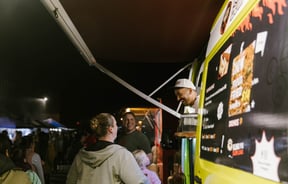
Christchurch may be a long jaunt from Kathmandu, but you won't have to go nearly as far for momo dumplings.
The Margaret Mahy Family Playground
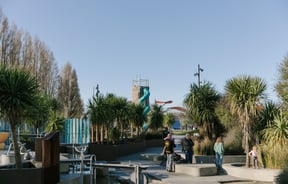
If you have kids and are looking for a way to burn some energy in Christchurch’s city centre, look no further than the beloved Margaret Mahy Family Playground.
Rascal

Located in the heart of the CBD on Christchurch’s High Street, Rascal is a modern bistro offering innovative food and exceptional cocktails.
Okuti Garden
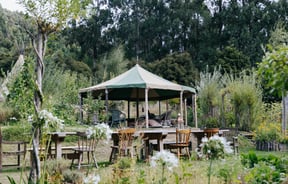
A garden for creating, learning, playing and celebrating. And a garden you can stay in.

